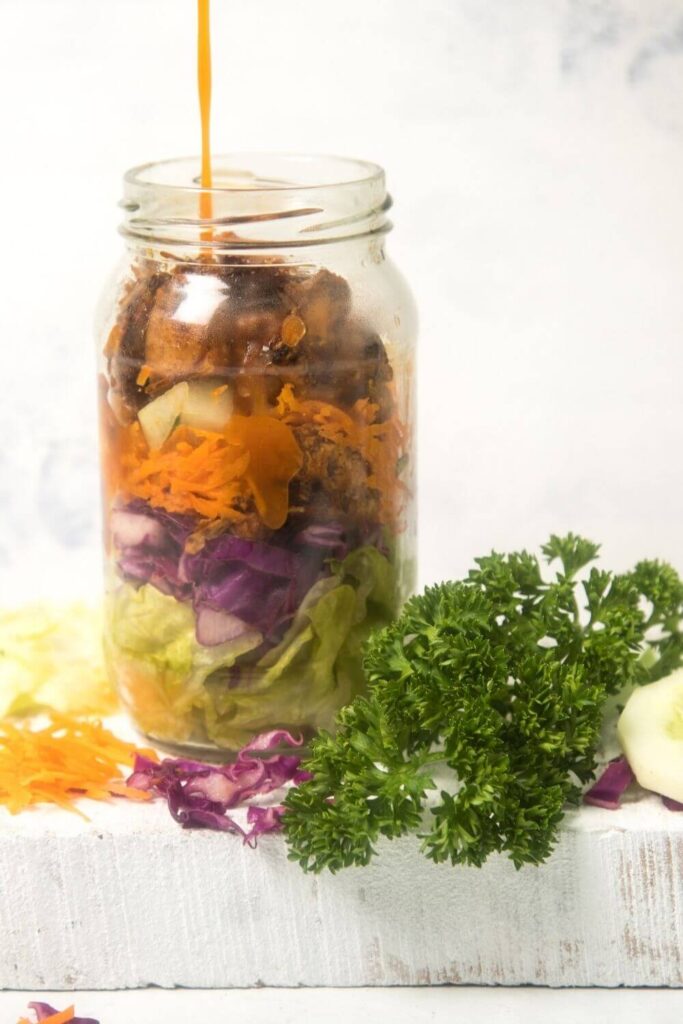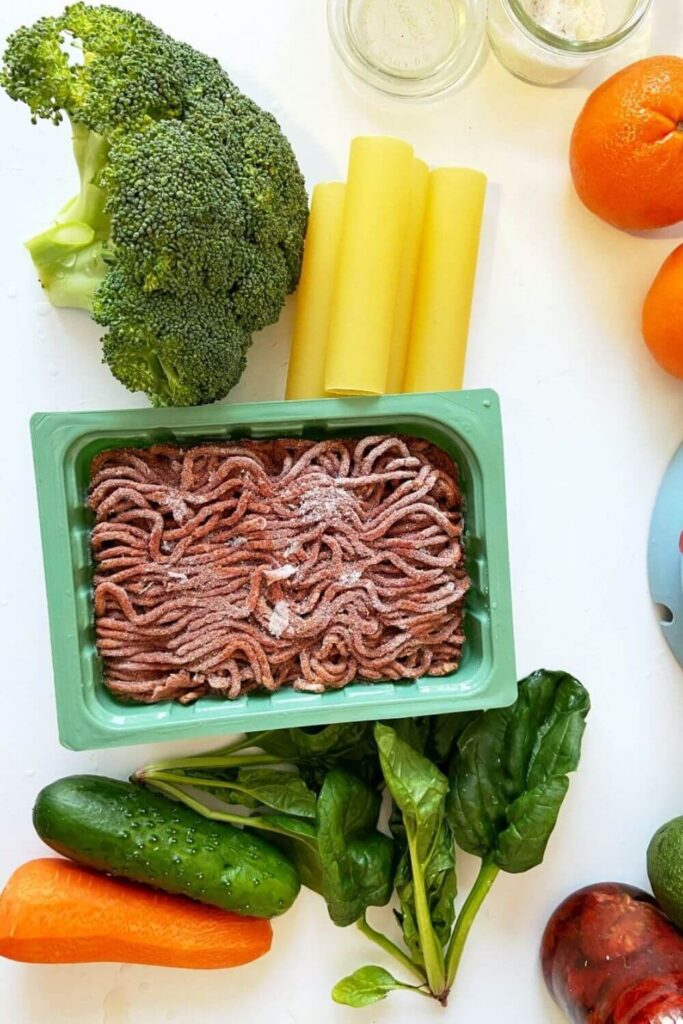Chances are you’re already implementing some zero waste tips. Which likely means you’re also starting to tackle the hefty challenge of cooking up a zero waste kitchen.
Perhaps like many people, you’ve run into a big obstacle in this department: freezing meat without plastic wrap or freezer bags.
If you eat meat, part of that will mean learning how to freeze meat without plastic (see our video above on non-plastic storage options).
Preserving food and preventing food waste is all the more important with animal products, especially considering their environmental impact is far greater than that of other types of food.
Our planet may be at steak—but we can help it by figuring out how to freeze steak properly (and without plastic).
Whether you’re pescatarian, paleo, or protein-lover, let’s take a bite out of some zero waste meat freezing techniques.
You can purchase reusable silicon zip lock bags which can go in the dishwasher. Since they are dishwasher safe, they can withstand the heat needed to kill germs associated with raw meat.

BEST CONTAINERS FOR FREEZING MEAT WITHOUT PLASTIC

So what are the best plastic free food storage containers for freezing meat?
Perhaps surprisingly, there are multiple options.
We’ve already given you a few tips for old glass jars that can be used, but, as this is the MOST eco-friendly option, here are a few more:
- Glass baby food jars for tight storage and smaller portions
- Glass milk bottles for soups and stews
- Jam jars to store single-servings of cooked or raw meat
- Large coconut oil jars for bigger portions
Start a collection of several sizes and shapes of used glass jars. Just don’t forget to label them with the contents and date!
Again, don’t fill them too full or else risk them breaking.
If you’re ready to invest in something new for your eco-friendly kitchen, try a metal container. The best thing with metal is that you can be sure it won’t break.
- U Konserve has a few different sizes of stainless steel containers complete with a silicone lid. They’re free of BPA, phthalates, and lead.
- Ecolunchbox also has different size options for their range of eco friendly lunch boxes with food-grade silicone lids. These are also free of BPA, BPS, and phthalates.
- For something a little larger, Nestable stainless steel containers are airtight, watertight, and made from food-grade stainless steel. The bases are dishwasher safe, too.
If you want to level up from upcycled glass jars, there are several more durable options available.
Look for borosilicate or tempered glass, which is up to five times stronger than normal glass as well as scratch, stain, and odor-resistant.
- Glasslock containers are available individually or in an 18-piece assortment. They’re all freezer-safe, oven-safe, microwavable, leak-proof, and airtight. Aussies can buy them from Biome here.
- Frego also has freezer-friendly, glass storage options in different sizes and colors.
- For canning-type jars with a variety of sizes and lid types (including clip top), Kilner is the brand to choose.
These are a must-have in any plastic-free kitchen.
Not only are they super useful for taking your lunch to-go, but they’re one of the best solutions for freezing meat without plastic bags.
There are several different sizes to choose from, each made with 100% pure platinum grade silicone. All bags are freezer-friendly, dishwasher safe (upper rack only), and free of phthalates, latex, lead, BPS, and BPA.
They’ve even teamed up with TerraCycle to accept damaged or used bags for proper recycling.
QUICK LINKS FOR HOW TO FREEZE MEAT WITHOUT PLASTIC

Plastic is—and has been for decades—the premier choice for food preservation. This goes for meat, too.
In fact, it goes especially for meat. Because of the higher bacterial risk meat poses, people often resort to disposable storage solutions rather than worry about thoroughly cleaning something reusable.
Plastic cling wrap and plastic Ziploc bags are found in nearly all kitchens and are typically used to store both raw and leftover meat like chicken breasts, sausage links, ground beef, and steak fillets.
Although it doesn’t work as well, aluminum foil is also a common choice for storing meat in the freezer. However, it’s limited by its ability to only work a short time, as holey or improperly sealed aluminum foil can lead to freezer burn and messy thawing.
Reusable plastic containers are similar. They can work for a short period of time but are prone to cracking and breaking as they get brittle in cold, freezer temperatures.
There’s also the lazy approach of freezing meat directly in the wrapping it came in from the supermarket. This is only advisable for short-term freezing because it’s not as air-tight as some other options—unless you suck extra air out using a straw.
For fancy meat-eaters, an at-home vacuum sealer is also often used. This utilizes a plastic film but preserves meat for long periods of time without risk of freezer burn.
Then there’s freezer paper, a heavy-duty paper coated on one side with plastic. Freezer paper is often used in combination with some of the other options because it preserves the meat, holds the juices, and can be placed in a bag or wrapped in aluminum foil for even better storage.
Don’t get us wrong, we commend any efforts to prevent food waste but unfortunately, a 2018 study found that plastic packaging might not even prevent food waste.
In fact, it can actually even help cause more food waste.
So you may be wondering how to freeze raw meat without using tin foil or plastic wrap…
Let’s see how we can make these food preservation strategies even better—by saying “peace out” to plastic.
Freezing meat without plastic – Eco options for keeping meat in the freezer
FAQ
Can you freeze meat in reusable bags?
Can you reuse freezer bags with raw meat?
Can you put reusable bags in the freezer?
Can you use storage bags to freeze meat?
Can you freeze meat in a plastic bag?
Plastic bags are not the ideal option for freezing meat, as they’re less sturdy compared to other freezer bags, making them prone to tearing and leaking. This can lead to freezer burn and cross-contamination. Plastic bags are also not generally airtight, causing freezer burn and affecting the taste and texture of the meat.
What are the best freezer bags for storing meat?
Hefty’s Slider freezer bags are another excellent bag for storing meat in the freezer. They’re made from strong and durable plastic that effectively protects against freezer burn, while the slider seal design also ensures that opening and closing the bags is easy breezy.
How do you store meat in a freezer?
Always wash your hands before and after handling meat. Use separate cutting boards and utensils for meat and other foods to avoid cross-contamination. Store meat in the refrigerator or freezer within one to two hours of purchasing it. Use freezer bags specifically designed for meat storage to prevent freezer burn and extend shelf life.
Can You reuse frozen meat?
While in theory, some of the plastic-based materials used for freezing meat (wraps, bags, and containers) can be reused, they pose a health risk due to possible food-borne illnesses and contamination. Their recycling rate is just as problematic. Just one-fifth of 1%, or 0.2% of Ziploc bags actually end up being recycled.
